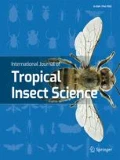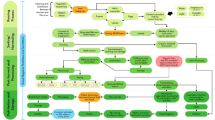Abstract
The use of insects as food and feed is widespread worldwide due to their attractive nutritional profile comparable to that of conventional livestock. In particular, edible grasshoppers act as a food source to many tribes in East and Central Africa but still harvested from their natural habitats. In this perspective, the health hazards associated with consumption of grasshoppers ought to be investigated. The present review assesses the risks (microbiological and heavy metals hazards) of wild-harvested Ruspolia differens (Serville) (Orthoptera: Tettigonidae) and compares with the levels recommended for minced meat as an indicator of food safety for edible insects. In addition, the effect of common processing methods in reducing the risks is stated. Due to the scarcity of the data, other edible grasshoppers within the order Orthoptera have been included in the review. The risks identified as main hazards include: (1) high total viable counts; (2) high counts of Enterobacteriaceae and lactic acid bacteria; (3) high counts of yeasts and moulds; and (4) accumulation of lead and other heavy metals. Conventional processing methods are effective in reducing microbiological hazards except for bacterial endospores. Important data gaps regarding edible grasshoppers and their safety include: (1) lack of data on bacterial communities (raw and processed); (2) fungal communities and mycotoxins-producing fungi; (3) studies on shelf life of processed edible grasshoppers; (4) limited data on heavy metals on whole grasshoppers and derived products; and (5) lack of data on parasites, viruses, antimicrobial resistance and veterinary medicinal products. Future aspect should focus on sustainable farming of grasshoppers using different diets in controlled environments and risks profiling. The present review explores food safety risks related to consumption of edible grasshoppers, from wild collections to consumption.
Similar content being viewed by others
References
Agea JG, Biryomumaisho D, Buyinza M, Nabanoga GN (2008) Commercialization of Ruspolia nitidula (nsenene grasshoppers) in Central Uganda. Afr J Food Agric Nutr Dev 8:291–303
Belluco S, Losasso C, Maggioletti M, Alonzi CC, Paoletti MG, Ricci A (2013) Edible insects in a food safety and nutritional perspective: a critical review. Compr Rev Food Sci Food Saf 12:296–313. https://doi.org/10.1111/1541-4337.12014
Bennett JW, Klich M (2003) Mycotoxins. Clin Microbiol Rev 16:497–516. https://doi.org/10.1128/CMR.16.3.497
Brits JA, Thorton CH (1981) On the biology of Ruspolia differens (serville) (Orthoptera: Tettigoniidae) in South Africa. Phytophylactica 173:169–173
Caparros Megido R, Desmedt S, Blecker C, Béra F, Haubruge É, Alabi T, Francis F (2017) Microbiological load of edible insects found in Belgium. Insects 8:1–8. https://doi.org/10.3390/insects8010012
Caparros Megido R, Poelaert C, Ernens M, Liotta M, Blecker C, Danthine S, Francis F (2018) Effect of household cooking techniques on the microbiological load and the nutritional quality of mealworms (Tenebrio molitor L. 1758). Food Res Int 106:503–508. https://doi.org/10.1016/j.foodres.2018.01.002
Christensen DL, Orech FO, Michael N, Larsen T, Friis H (2006) Entomophagy among the Luo of Kenya: a potential mineral source? Int J Food Sci Nutr 57:198–203. https://doi.org/10.1080/09637480600738252
Commission Regulation (EC) No 1881/2006 of The European Parliament and of the Council of 19 December 2006 on setting maximum levels for certain contaminants in foodstuffs and amending Commission Regulation (EC) No 466/2001 of 8 March 2001 setting maximum levels for certain contaminants in foodstuff in line with new information and developments in Codex Alimentarius
D’Souza C, Peretiatko R (2000) The nexus between industrialization and environment: a case study of Indian enterprises. Environ Manag Health 13:80–97. https://doi.org/10.1108/09566160210417859
Devkota B, Schmidt GH (1999) Accumulation of heavy metals in food plants and grasshoppers from. Agric Ecosyst Environ 78:85–91. https://doi.org/10.1016/S0167-8809(99)00110-3
European Food Safety Authority (2015) Risk profile related to production and consumption of insects as food and feed. EFSA J 13:4257. https://doi.org/10.2903/j.efsa.2015.4257
Fijan S (2014) Microorganisms with claimed probiotic properties: an overview of recent literature. Int J Environ Res Public Health 11:4745–4767. https://doi.org/10.3390/ijerph110504745
Fombong F, Van Der Borght M, Vanden Broeck J (2017) Influence of Freeze-Drying and Oven-Drying Post Blanching on the Nutrient Composition of the Edible Insect Ruspolia differens. Insects 8(3):102
Garofalo C, Osimani A, Milanović V, Taccari M, Cardinali F, Aquilanti L, Clementi F (2017) The microbiota of marketed processed edible insects as revealed by high-throughput sequencing. Food Microbiol 62:15–22. https://doi.org/10.1016/j.fm.2016.09.012
Garofalo C, Milanović V, Cardinali F, Aquilanti L, Clementi F, Osimani A (2019) Current knowledge on the microbiota of edible insects intended for human consumption: a state-of-the-art review. Food Res Int 125:108527. https://doi.org/10.1016/j.foodres.2019.108527
Gatheru JW, Khamis FM, Ombura FLO, Nonoh J, Tanga CM, Maina J, Subramanian S (2019) Impact of processing methods on microbial load of reared and wild-caught edible crickets (Scapsipedus icipe and Gryllus bimaculatus) in Kenya. J Insects Food Feed 5:171–183. https://doi.org/10.3920/JIFF2018.0042
Ghafir Y, China B, Dierick K, De Zutter L, Daube G (2008) Hygiene indicator microorganisms for selected pathogens on beef, pork, and poultry meats in Belgium. J Food Prot 71:35–45
Grabowski N, Klein G (2017a) Microbiological analysis of raw edible insects. J Insects Food Feed 3:7–14. https://doi.org/10.3920/JIFF2016.0004
Grabowski N, Klein G (2017b) Microbiology of processed edible insect products – results of a preliminary survey. Int J Food Microbiol 243:103–107. https://doi.org/10.1016/j.ijfoodmicro.2016.11.005
Handley MA, Hall C, Sanford E, Diaz E, Gonzalez-mendez E, Drace K, Croughan M (2007) Globalization, binational communities, and imported food risks: results of an outbreak investigation of lead poisoning in Monterey County, California. Am J Public Health 97:900–906. https://doi.org/10.2105/AJPH.2005.074138
Hyun SH, Kwon KH, Park KH, Hjeong HC, Kwon O, Tindwa H, Han YS (2012) Evaluation of nutritional status of an edible grasshopper, Oxya Chinensis Formosana. Entomol Res 42:284–290. https://doi.org/10.1111/j.1748-5967.2012.00469.x
Imathiu S (2020) Benefits and food safety concerns associated with consumption of edible insects. NFS J 18:1–11. https://doi.org/10.1016/j.nfs.2019.11.002
Kasozi KI, Namazi C, Basemera E, Atuheire C, Odwee A, Majalija S, Kateregga JN (2019) Inorganic pollutants in edible grasshoppers (Ruspolia nitidula) of Uganda and their major public health implications. Afr Health Sci 19:2679–2691
Kelemu S, Niassy S, Torto B, Fiaboe K, Affognon H, Tonnang H, Ekesi S (2015) African edible insects for food and feed: inventory, diversity, commonalities and contribution to food security. J Insects Food Feed 1:103–119. https://doi.org/10.3920/JIFF2014.0016
Kinyuru J, Kenji G, Muhoho S, Ayieko M (2010) Nutritional potential of longhorn grasshopper (Ruspolia differens) consumed in Siaya district, Kenya. J Agric Sci Technol 12:32–46
Klunder HC, Wolkers-Rooijackers J, Korpela JM, Nout MJR (2012) Microbiological aspects of processing and storage of edible insects. Food Control 26:628–631. https://doi.org/10.1016/j.foodcont.2012.02.013
Köhler R, Kariuki L, Lambert C, Biesalski HK (2019) Protein, amino acid and mineral composition of some edible insects from Thailand. J Asia Pac Entomol 22:372–378. https://doi.org/10.1016/j.aspen.2019.02.002
Leonard A, Khamis FM, James PE, Kyamanywa S, Ekesi S, Tanga CM, Copeland RS, Subramanian S (2020) Identification of edible short-and long-horned grasshoppers and their host plants in East Africa. J Econ Entomol 113:2150–2162. https://doi.org/10.1093/jee/toaa166
Lundy ME, Parrella MP (2015) Crickets are not a free lunch : protein capture from scalable organic side-streams via high-density populations of Acheta domesticus. PLoS One 10:1–12. https://doi.org/10.1371/journal.pone.0118785
Matojo ND (2017) A review work on how to differentiate the longhorn grasshoppers Ruspolia differens and Ruspolia nitidula (Orthoptera: Tettigoniidae). J Appl Life Sci Int 15(2):1–4. https://doi.org/10.9734/JALSI/2017/37912
Mmari MW, Kinyuru JN, Laswai HS, Okoth JK (2017) Traditions, beliefs and indigenous technologies in connection with the edible longhorn grasshopper Ruspolia differens (Serville 1838) in Tanzania. J Ethnobiol Ethnomed 13:1–11. https://doi.org/10.1186/s13002-017-0191-6
Murefu TR, Macheka L, Musundire R, Manditsera FA (2019) Safety of wild harvested and reared edible insects: a review. Food Control 101:209–224. https://doi.org/10.1016/j.foodcont.2019.03.003
Musundire R, Osuga IM, Cheseto X, Irungu J, Torto B (2016) Aflatoxin contamination detected in nutrient and anti-oxidant rich edible stink bug stored in recycled grain containers. PLoS One 11:1–16. https://doi.org/10.1371/journal.pone.0145914
Nakagaki BJ, DeFoliarT GR (1991) Comparison of diets for mass-rearing Acheta domesticus (Orthoptera : Gryllidae) as a novelty food and comparison of food conversion efficiency with values reported for livestock. J Econ Entomol 84:891–896
Ng’ang’a J, Imathiu S, Fombong F, Ayieko M, Vanden Broeck J, Kinyuru J (2018) Microbial quality of edible grasshoppers Ruspolia differens (Orthoptera: Tettigoniidae): from wild harvesting to fork in the Kagera region, Tanzania. J Food Saf 12549:1–6. https://doi.org/10.1111/jfs.12549
Nowak V, Persijn D, Rittenschober D, Charrondiere UR (2016) Review of food composition data for edible insects. Food Chem 193:39–46. https://doi.org/10.1016/j.foodchem.2014.10.114
Nyangena DN, Mutungi C, Imathiu S, Kinyuru J, Affognon H, Ekesi S, Nakimbugwe D, Fiaboe KKM (2020) Effects of Traditional Processing Techniques on the Nutritional and Microbiological Quality of Four Edible Insect Species Used for Food and Feed in East Africa. Foods 9(5):574
Oonincx DGAB, Van Itterbeeck J, Heetkamp MJW, Van Den Brand H, Van Loon JJA, Van Huis A (2010) An exploration on greenhouse gas and ammonia production by insect species suitable for animal or human consumption. PLoS One 5:1–7. https://doi.org/10.1371/journal.pone.0014445
Poma G, Cuykx M, Amato E, Calaprice C, Focant JF, Covaci A (2017) Evaluation of hazardous chemicals in edible insects and insect-based food intended for human consumption. Food Chem Toxicol 100:70–79. https://doi.org/10.1016/j.fct.2016.12.006
Rimmer CC, Miller EK, Faccio SD (2010) Mercury bioaccumulation and trophic transfer in the terrestrial food web of a montane forest. Ecotoxicology 19:697–709. https://doi.org/10.1007/s10646-009-0443-x
Rumpold BA, Schlüter OK (2013) Nutritional composition and safety aspects of edible insects. Mol Nutr Food Res 57:802–823. https://doi.org/10.1002/mnfr.201200735
Schabel HG (2008) Forest insects as food: A global review. In Edible Forest Insect: Human Bite Back, Proceedings of a Workshop on Asia-Pacific Resources and Their Potential for Development, Chiang Mai, Thailand, 19–21 February 2008; Durst PB, Johnson DV, Leslie RN, Shono K, Eds.; Food and Agriculture Organization of the United Nations: Bangkok, Thailand, 2010
Schlüter O, Rumpold B, Holzhauser T, Roth A, Vogel RF, Quasigroch W, Vogel S, Heinz V, Jäger H, Bandick N, Kulling S, Knorr D, Steinberg P, Engel KH (2017) Safety aspects of the production of foods and food ingredients from insects. Mol Nutr Food Res 61:1600520
Sheng Z, Zheng DM, Wang QC, Lv XG (2009) Bioaccumulation of total and methyl mercury in three earthworm species (Drawida sp., Allolobophora sp., and Limnodrilus sp.). Bulletin of Environmental Contamination and Toxicology 83:937–942
Ssepuuya G, Mukisa IM, Nakimbugwe D (2016a) Nutritional composition, quality, and shelf stability of processed Ruspolia nitidula (edible grasshoppers). Food Sci Nutr 5:103–112. https://doi.org/10.1002/fsn3.369
Ssepuuya G, Aringo RO, Mukisa IM, Nakimbugwe D (2016b) Effect of processing, packaging and storage-temperature based hurdles on the shelf stability of sautéed ready-to-eat Ruspolia nitidula. J Insects Food Feed 2:245–253
Ssepuuya G, Smets R, Nakimbugwe D, Van Der Borght M, Claes J (2019a) Nutrient composition of the long-horned grasshopper Ruspolia differens Serville: effect of swarming season and sourcing geographical area. Food Chem 301:125305. https://doi.org/10.1016/j.foodchem.2019.125305
Ssepuuya G, Wynants E, Verreth C, Crauwels S, Lievens B, Claes J, Van Campenhout L (2019b) Microbial characterisation of the edible grasshopper Ruspolia differens in raw condition after wild-harvesting in Uganda. Food Microbiol 77:106–117. https://doi.org/10.1016/J.FM.2018.09.005
Stoops J, Crauwels S, Waud M, Claes J, Lievens B, Van Campenhout L (2016) Microbial community assessment of mealworm larvae (Tenebrio molitor) and grasshoppers (Locusta migratoria migratorioides) sold for human consumption. Food Microbiol 53:122–127. https://doi.org/10.1016/j.fm.2015.09.010
van Huis A (2013) Potential of insects as food and feed in assuring food security. Annu Rev Entomol 58:563–583. https://doi.org/10.1146/annurev-ento-120811-153704
Vandeweyer D, Lenaerts S, Callens A, Van Campenhout L (2017) Effect of blanching followed by refrigerated storage or industrial microwave drying on the microbial load of yellow mealworm larvae (Tenebrio molitor). Food Control 71:311–314. https://doi.org/10.1016/j.foodcont.2016.07.011
Vandeweyer D, Wynants E, Crauwels S, Verreth C, Viaene N, Claes J, Van Campenhout L (2018) Microbial dynamics during industrial rearing, processing, and storage of tropical house crickets (Gryllodes sigillatus) for human consumption. Appl Environ Microbiol 84:1–12. https://doi.org/10.1128/AEM.00255-18
Wani AL, Ara A, Usmani JA (2015) Lead toxicity : a review. Interdiscip Toxicol 8:55–64. https://doi.org/10.1515/intox-2015-0009
Zhang ZS, Lu XG, Wang QC, Zheng DM (2009) Mercury, cadmium and lead biogeochemistry in the soil-plant-insect system in Huludao city. Bull Environ Contam Toxicol 83:255–259. https://doi.org/10.1007/s00128-009-9688-6
Author information
Authors and Affiliations
Corresponding author
Ethics declarations
Conflict of interest
The authors declare no conflict of interest.
Additional information
Publisher’s note
Springer Nature remains neutral with regard to jurisdictional claims in published maps and institutional affiliations.
Rights and permissions
About this article
Cite this article
Ng’ang’a, J., Fombong, F., Kiiru, S. et al. Food safety concerns in edible grasshoppers: a review of microbiological and heavy metal hazards. Int J Trop Insect Sci 41, 2103–2111 (2021). https://doi.org/10.1007/s42690-020-00372-9
Received:
Accepted:
Published:
Issue Date:
DOI: https://doi.org/10.1007/s42690-020-00372-9




